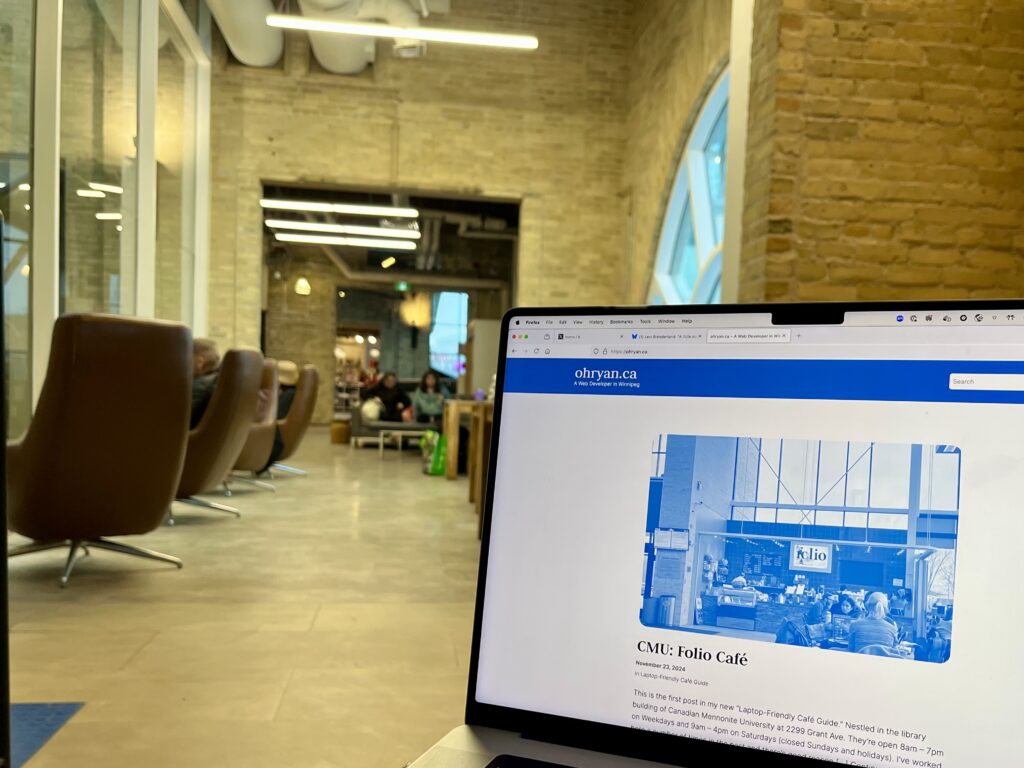The Forks is one of Winnipeg’s few attractions that was explicitly designed as a classic “tourist trap” which might make it seem like a strange choice for remote work. However, while it’s one of the city’s most lively spots on weekends throughout the year, it does tend to be quite slow on a weekday afternoon.
Also, the posters on r/Winnipeg specifically suggested the second floor in The Forks Market building. And now that’s kind of an interesting suggestion. It seems that a few years ago after losing a major tenant, they removed all the walls and added a tonne of seating and tables. While it serves as overflow for The Commons food hall on busy days, an old Facebook post reveals it was explicitly designed as a chill work/meeting space.
The Forks only really has one legit coffee shop Fools & Horses, so they’ll be the primary subject of the food and coffee portion of this review.
Vibe – 3/5
Dingy train station vibes!
As a lifelong Winnipegger, giving The Forks a less than stellar review is a bold move! But remember, this is specifically a review of the remote work experience on the second floor.
I love The Forks! The Commons, specifically the outdoor patio, is one of my favourite in the city, period!
With that out of the way, let’s talk about the dingy vibe.
First of all, it stinks, literally. The Forks Market building originally housed the Grand Trunk Pacific Railway’s Stables and I believe it served as a machine shop after that. It seems like that half century or more of stench continues to be released from the brickwork. This aroma combines with the grease exhaust from the food prepared below to form quite the unpleasant concoction. I’m smelling it emanating from my clothes as I write this.
Second, the second floor seating area seems like a forgotten corner of the market. While I did notice cleaning staff an security check-in a few times in the two hours I was there, the general vibe is dingy and forgotten. The floor is just a little grimy. The walls are barren. It could really use some plants and artwork to liven up the place.
The ‘train station’ vibe is actually what saves this section from a lower score. The soaring ceilings and tall windows create that distinct public transit hall atmosphere. This feeling is amplified by the eclectic mix of people you’ll find here: random shoppers getting off their feet, professionals focused over laptops, a dad catching a nap on a couch, random teenagers killing time. There’s something oddly comforting about this liminal space.

Coffee – 3/5
Fools & Horses doesn’t make a cortado, rather they sell a “gibraltar.” I’d always thought this was a random nod to the nearby Fort Gibraltar.
Wikipedia has this to say about the gibraltar:
The name gibraltar originated in San Francisco, where roasters…started the cortado trend by serving the drink in Libbey Glass Company glassware by the same name.
The drink I received doesn’t quite match the wiki article’s description, so I’m still partial to my Fort Gibraltar theory.
The coffee itself was fine, though pulled a bit long maybe.
Food – 3/5
A reminder that this is a mini-review of Fools & Horses’ snack options specifically, not The Forks in general (The Commons food court is a solid 5/5!).
Fools & Horses stocks donuts from Oh Doughnuts, as well as other snacks from an undisclosed location. During my mid-afternoon visit, the pastry case held about 5 remaining donuts – not bad. The other treats were wrapped in plastic, suggesting they’re at least a day old 👎
I had a vegan “Twix” doughnut. It was very good.
Seating – 5/5


The seating is the real selling feature of this place and I suspect what r/Winnipeg most likes about this place. There is a lot of it and it’s relatively secluded from the mall-like atmosphere of the rest of the market.
There’s a large number of solid wooden tables for four, big enough that I wouldn’t feel like I was intruding if I had to share with another laptoper. There are also a number of couches and arm chairs. As well as a few large swivel chairs, a few of them overlooking the food court.
I found the tables to be slightly uncomfortable to sit at, so switched to a swivel chair and it was most excellent.
As you can see there a large amount of lighting, both from the overhead fluorescents as well as the large windows. Watching a peaceful snowfall would be downright cinematic.
Location – 5/5
It’s The Forks! Right in the heart of the city. A good amount of car and bike parking.
A couple of tips though:
Bike Valet
If you cycle down, Winnipeg Trails offers a bike valet service in their shop right next to the patio. They ask for a $2 donation in exchange. So you don’t have to worry about leaving your bike outside.
EV Charging
There are a total of 6 free EV chargers, but four of them are kind of hidden:
- 2xJ-1772 – directly in front of the Forks Market building.
- 1xJ-1772, 1xNACS – on the first floor of the parkade.
- 1xJ-1772, 1xNACS – behind the Inn at the Forks building (AFAIK this is Parks Canada parking, not reserved guest parking).
I should also mention that unlike many other places I’ll be reviewing, car parking is not free. It’s $2.50/hr.
Overall – 18/25
Overall the second floor of The Forks is a solid bet, if you’re into liminal spaces and don’t mind a little grime.
Fools & Horses is totally fine, but if you’re thinking about maybe grabbing lunch or a beer from The Common’s vast selection of local brews, I’d say skip F&H.
As with other downtown locations I’ll be reviewing, if you’re driving or bussing, plan to head out before 4:00 to avoid rush hour traffic. I learned this the hard way, leaving at 4:45 and getting a stark reminder of why working from home is such a privilege.
In the end, there’s something fitting about doing modern remote work in this historic railway building – it’s a uniquely Winnipeg mix of practical necessity and historic grandeur.


